Discover 35 hidden attractions, cool sights, and unusual things to do in Istanbul (Turkey). Don't miss out on these must-see attractions: Hagia Sophia, Topkapı Palace, and Blue Mosque. Also, be sure to include Basilica Cistern in your itinerary.
Below, you can find the list of the most amazing places you should visit in Istanbul (Istanbul).
Table of Contents
Hagia Sophia
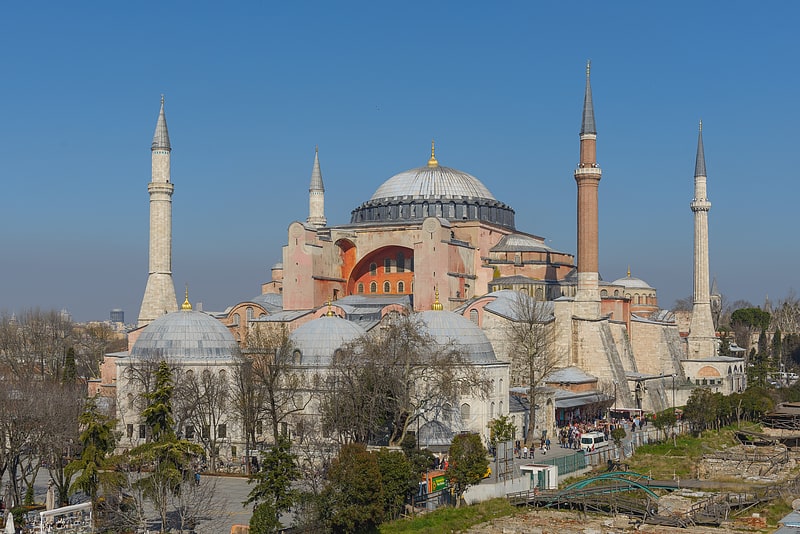
Also known as: Ayasofya
Byzantine basilica museum with mosaics. Hagia Sophia, officially known as the Holy Hagia Sophia Grand Mosque and formerly as the Church of Holy Wisdom, is a Late Antique place of worship in Istanbul, designed by the Greek geometers Isidore of Miletus and Anthemius of Tralles. Built in 537 as the patriarchal cathedral of the imperial capital of Constantinople, it was the largest Christian church of the eastern Roman Empire and the Eastern Orthodox Church, except during the Latin Empire from 1204 to 1261, when it temporarily became a Roman Catholic cathedral. In 1453, after the Fall of Constantinople to the Ottoman Empire, it was converted into a mosque. In 1935, the Republic of Turkey established it as a museum, a role it served for 85 years until it its status was annulled and it was re-converted into a mosque in 2020.
Built by the eastern Roman emperor Justinian I as the Christian cathedral of Constantinople for the state church of the Roman Empire between 532 and 537, the church was then the world's largest interior space and among the first to employ a fully pendentive dome. It is considered the epitome of Byzantine architecture and is said to have "changed the history of architecture". The present Justinianic building was the third church of the same name to occupy the site, as the prior one had been destroyed in the Nika riots. As the episcopal see of the ecumenical patriarch of Constantinople, it remained the world's largest cathedral for nearly a thousand years, until Seville Cathedral was completed in 1520. Beginning with subsequent Byzantine architecture, Hagia Sophia became the paradigmatic Orthodox church form, and its architectural style was emulated by Ottoman mosques a thousand years later. It has been described as "holding a unique position in the Christian world" and as an architectural and cultural icon of Byzantine and Eastern Orthodox civilization.
The religious and spiritual centre of the Eastern Orthodox Church for nearly one thousand years, the church was dedicated to the Holy Wisdom. It was where the excommunication of Patriarch Michael I Cerularius was officially delivered by Humbert of Silva Candida, the envoy of Pope Leo IX in 1054, an act considered the start of the East–West Schism. In 1204, it was converted during the Fourth Crusade into a Catholic cathedral under the Latin Empire, before being resturned to the Eastern Orthodox Church upon the restoration of the Byzantine Empire in 1261. The doge of Venice who led the Fourth Crusade and the 1204 Sack of Constantinople, Enrico Dandolo, was buried in the church.
After the Fall of Constantinople to the Ottoman Empire in 1453, it was converted to a mosque by Mehmed the Conqueror and became the principal mosque of Istanbul until the 1616 construction of the Sultan Ahmed Mosque. Upon its conversion, the bells, altar, iconostasis, ambo, and baptistery were removed, while iconography, such as the mosaic depictions of Jesus, Mary, Christian saints and angels were removed or plastered over. Islamic architectural additions included four minarets, a minbar and a mihrab. The Byzantine architecture of the Hagia Sophia served as inspiration for many other religious buildings including the Hagia Sophia in Thessaloniki, Panagia Ekatontapiliani, the Şehzade Mosque, the Süleymaniye Mosque, the Rüstem Pasha Mosque and the Kılıç Ali Pasha Complex. The patriarchate moved to the Church of the Holy Apostles, which became the city's cathedral.
The complex remained a mosque until 1931, when it was closed to the public for four years. It was re-opened in 1935 as a museum under the secular Republic of Turkey, and the building was Turkey's most visited tourist attraction in 2015 and 2019. In July 2020, the Council of State annulled the 1934 decision to establish the museum, and the Hagia Sophia was reclassified as a mosque. The 1934 decree was ruled to be unlawful under both Ottoman and Turkish law as Hagia Sophia's waqf, endowed by Sultan Mehmed, had designated the site a mosque; proponents of the decision argued the Hagia Sophia was the personal property of the sultan. This redesignation drew condemnation from the Turkish opposition, UNESCO, the World Council of Churches, the International Association of Byzantine Studies, and many international leaders.[1]
Address: Sultan Ahmet Mahallesi, Ayasofya Meydanı, 34122 Fatih (Fatih)
Topkapı Palace

Also known as: Topkapı Sarayı
Historic Ottoman-era palace complex. The Topkapı Palace, or the Seraglio, is a large museum in the east of the Fatih district of Istanbul in Turkey. In the 15th and 16th centuries it served as the main residence and administrative headquarters of the Ottoman sultans.
Construction, ordered by the Sultan Mehmed the Conqueror, began in 1459, six years after the conquest of Constantinople. Topkapı was originally called the "New Palace" (Yeni Saray or Saray-ı Cedîd-i Âmire) to distinguish it from the Old Palace (Eski Saray or Sarây-ı Atîk-i Âmire) in Beyazıt Square. It was given the name Topkapı, meaning Cannon Gate, in the 19th century. The complex expanded over the centuries, with major renovations after the 1509 earthquake and the 1665 fire. The palace complex consists of four main courtyards and many smaller buildings. Female members of the Sultan's family lived in the harem, and leading state officials, including the Grand Vizier, held meetings in the Imperial Council building.
After the 17th century, Topkapı gradually lost its importance. The sultans of that period preferred to spend more time in their new palaces along the Bosphorus. In 1856 Sultan Abdulmejid I decided to move the court to the newly built Dolmabahçe Palace. Topkapı retained some of its functions, including the imperial treasury, library and mint.
After the end of the Ottoman Empire in 1923, a government decree dated April 3, 1924 transformed Topkapı into a museum. Turkey's Ministry of Culture and Tourism now administers the Topkapı Palace Museum. The palace complex has hundreds of rooms and chambers, but only the most important are accessible to the public as of 2020, including the Ottoman Imperial Harem and the treasury, called hazine where the Spoonmaker's Diamond and the Topkapi Dagger are on display. The museum collection also includes Ottoman clothing, weapons, armor, miniatures, religious relics, and illuminated manuscripts such as the Topkapi manuscript. Officials of the ministry as well as armed guards of the Turkish military guard the complex. The Topkapı Palace forms a part the Historic Areas of Istanbul, a group of sites in Istanbul that UNESCO recognised as a World Heritage Site in 1985.[2]
Address: Cankurtaran Mh., 34122 Fatih (Fatih)
Blue Mosque
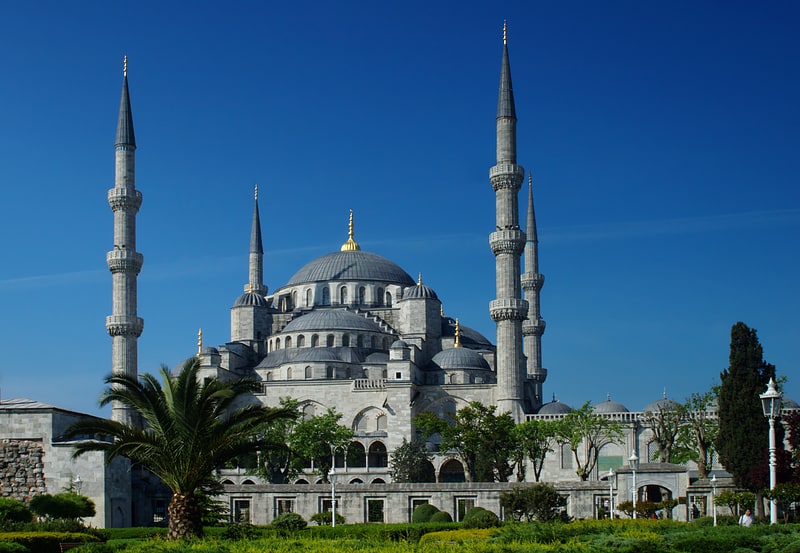
Also known as: Sultan Ahmet Camii
Iconic Blue Mosque with 6 minarets. The Blue Mosque in Istanbul, also known by its official name, the Sultan Ahmed Mosque, is an Ottoman-era historical imperial mosque located in Istanbul, Turkey. A functioning mosque, it also attracts large numbers of tourist visitors. It was constructed between 1609 and 1616 during the rule of Ahmed I. Its Külliye contains Ahmed's tomb, a madrasah and a hospice. Hand-painted blue tiles adorn the mosque’s interior walls, and at night the mosque is bathed in blue as lights frame the mosque’s five main domes, six minarets and eight secondary domes. It sits next to the Hagia Sophia, the principal mosque of Istanbul until the Blue Mosque's construction and another popular tourist site. The Blue Mosque was included in the UNESCO World Heritage Site list in 1985 under the name of "Historic Areas of Istanbul".[3]
Address: Sultan Ahmet Mahallesi, Atmeydanı Cd. No:7, 34122 Fatih (Fatih)
Basilica Cistern

Also known as: Yerebatan Sarnıcı
Restored 542 A.D. waterworks. The Basilica Cistern, or Cisterna Basilica, is the largest of several hundred ancient cisterns that lie beneath the city of Istanbul, Turkey. The cistern, located 150 metres southwest of the Hagia Sophia on the historical peninsula of Sarayburnu, was built in the 6th century during the reign of Byzantine Emperor Justinian I. Today it is kept with little water, for public access inside the space.[4]
Address: Alemdar Mh., Yerebatan Cd. 1/3, 34410 Fatih (Fatih)
Dolmabahçe Palace

Also known as: Dolmabahçe Sarayı
Museum in ornate Ottoman sultan's palace. Dolmabahçe Palace located in the Beşiktaş district of Istanbul, Turkey, on the European coast of the Bosporus strait, served as the main administrative center of the Ottoman Empire from 1856 to 1887 and from 1909 to 1922.[5]
Address: Vişnezade Mahallesi, Dolmabahçe Cd., 34357 Beşiktaş (Beşiktaş)
Istanbul Archaeology Museums
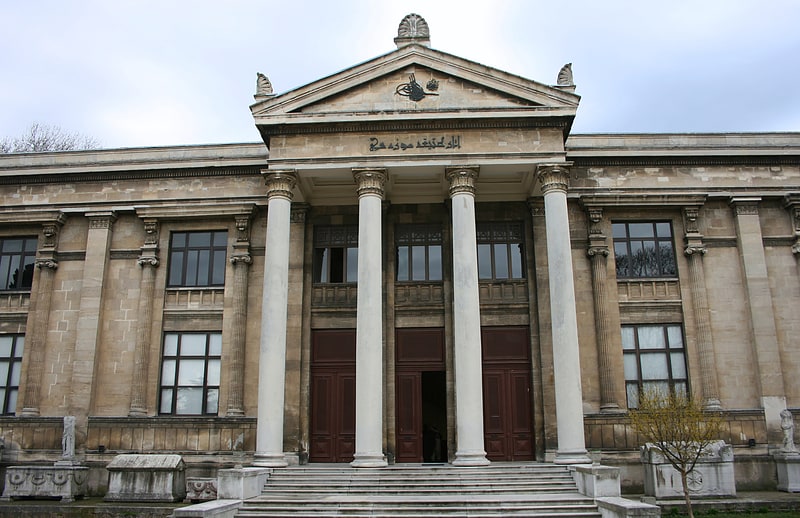
Also known as: İstanbul Arkeoloji Müzeleri
Museum of Turkish archaeological finds. The Istanbul Archaeology Museums are a group of three archaeological museums located in the Eminönü quarter of Istanbul, Turkey, near Gülhane Park and Topkapı Palace.
The Istanbul Archaeology Museums consists of three museums:
It houses over one million objects that represent almost all of the eras and civilizations in world history.[6]
Address: Cankurtaran Mh., 34122 Fatih (Fatih)
Sultanahmet Square
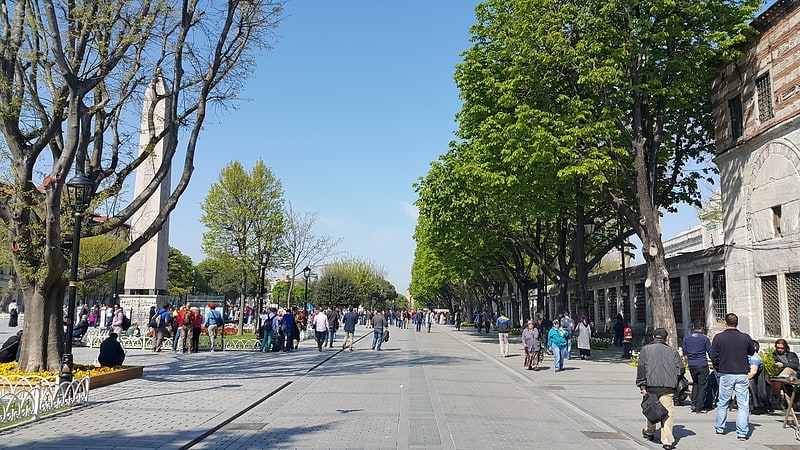
Also known as: Sultanahmet Meydanı
Public square where hippodrome stood. Sultanahmet Square, or the Hippodrome of Constantinople is a square in Istanbul, Turkey. Previously, it was a circus that was the sporting and social centre of Constantinople, capital of the Byzantine Empire.
The word hippodrome comes from the Greek hippos, horse, and dromos, path or way. For this reason, it is sometimes also called Atmeydanı in Turkish. Horse racing and chariot racing were popular pastimes in the ancient world and hippodromes were common features of Greek cities in the Hellenistic, Roman and Byzantine eras.[7]
Address: Binbirdirek Mh., Sultan Ahmet Parkı No:2, 34122 Fatih (Fatih)
Miniatürk
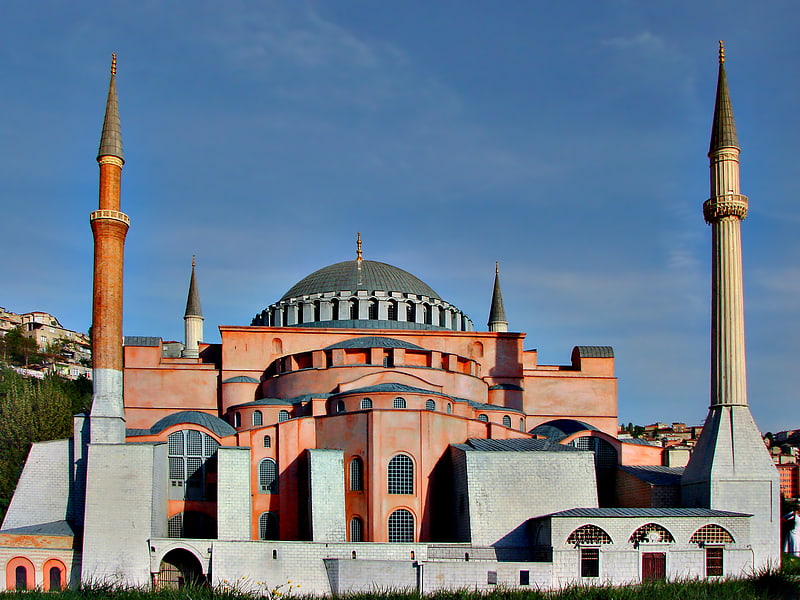
Turkey transformed into a model village. Miniatürk is a miniature park at the northeastern shore of Golden Horn in Istanbul, Turkey. It opened May 2, 2003. It is one of the world's largest miniature parks, with a 15,000 m2 model area and total area of 60,000 square metres. It contains 135 models, in 1:25 scale, of structures from in and around Turkey, and interpretations of historic structures.
Of the park's total area, 40,000 m2 (430,000 sq ft) is open space; 3,500 m2 (38,000 sq ft) is covered; and 2,000 m2 (22,000 sq ft) contain pools and waterways. Its parking lot has a capacity of 300 vehicles.
60 of the park's structures are from Istanbul, 63 are from Anatolia, and 13 are from the Ottoman territories that today lie outside of Turkey. Also featured are historic structures like the Temple of Artemis at Ephesus, and the Mausoleum of Maussollos at Halicarnassus (now Bodrum). Additional space is reserved for future models.[8]
Address: Örnektepe Mahallesi, İmrahor Cd. 7/1, 34445 Beyoğlu (Beyoğlu)
Spice Bazaar
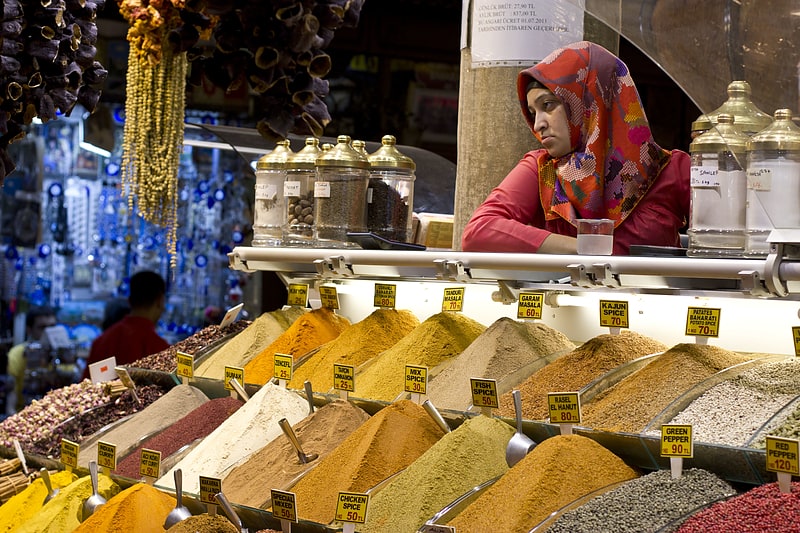
Also known as: Mısır Çarşısı
Historic covered spice and textiles market. The Spice Bazaar in Istanbul, Turkey is one of the largest bazaars in the city. Located in the Eminönü quarter of the Fatih district, it is the most famous covered shopping complex after the Grand Bazaar.[9]
Address: Rüstem Paşa Mahallesi, Erzak Ambarı Sok. No:92, 34116 Fatih (Fatih)
Galata Tower
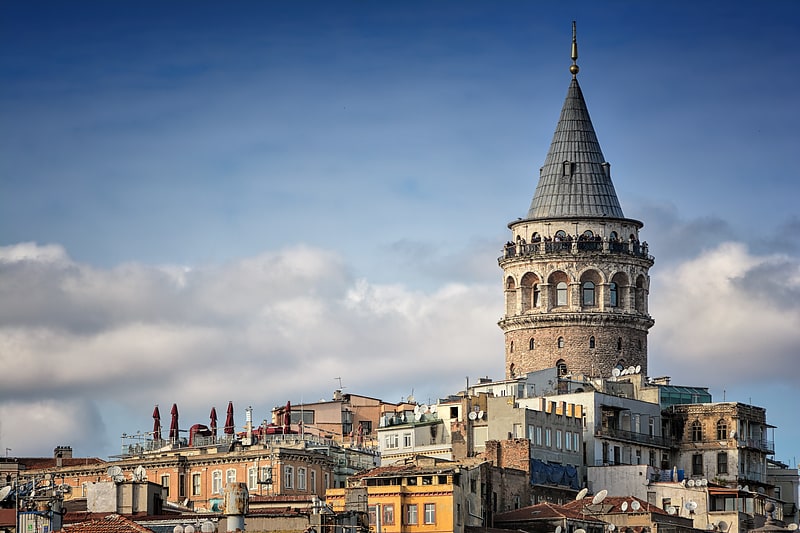
Also known as: Galata Kulesi
67-meter Byzantine tower and restaurant. The Galata Tower or with the current official name Galata Kulesi Museum is a tower in the Beyoğlu district of Istanbul, Turkey. Its namesake is the quarter where it's located, Galata. Built as a watchtower as a part of the Walls of Galata, the tower is currently being used as an exhibition place and a museum. It's one of the symbols of Beyoğlu and Istanbul.[10]
Address: Bereketzade Mahallesi, Galata Kulesi Sk., 34421 Beyoğlu (Beyoğlu)
Chora Church
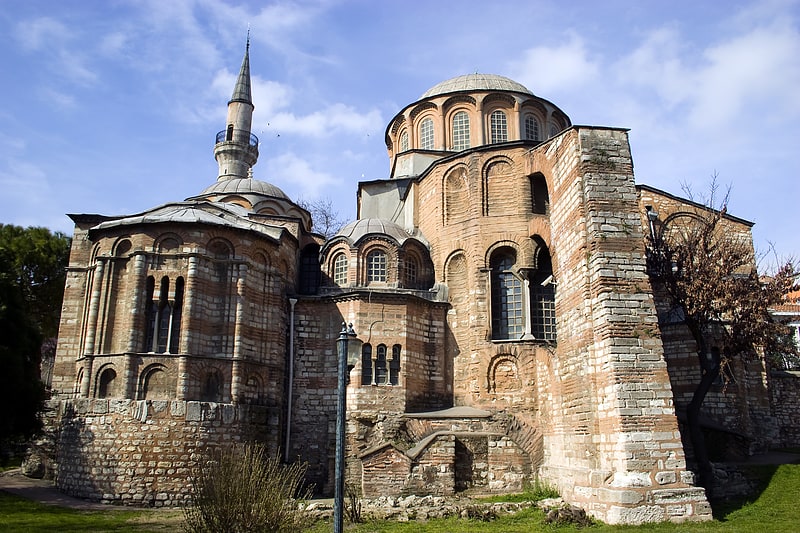
Also known as: Kariye Müzesi
Museum with Muslim and Christian artworks. The Kariye Mosque, or the Church of the Holy Saviour in Chora, is a medieval Greek Orthodox church, now used as a mosque, in the Edirnekapı neighborhood of Istanbul, Turkey. The neighborhood is situated in the western part of the municipality of the Fatih district. The building is an example of Byzantine architecture. In the 16th century, during the Ottoman era, it was converted into a mosque; it became a museum in 1945, and was turned back into a mosque in 2020 by President Recep Tayyip Erdoğan. Its desecularization has, however, been halted as of January 2021 due to lack of Islamic cultural significance and clerical interest in the site, compared to the Hagia Sophia. The interior of the building is covered with some of the oldest and finest surviving Byzantine Christian mosaics and frescoes; they were uncovered and restored after the building was secularized and turned into a museum.[11]
Address: Ortamahalle Mahallesi, Mezarlık Sk., 34010 Bayrampaşa/Fatih (Fatih)
New Mosque
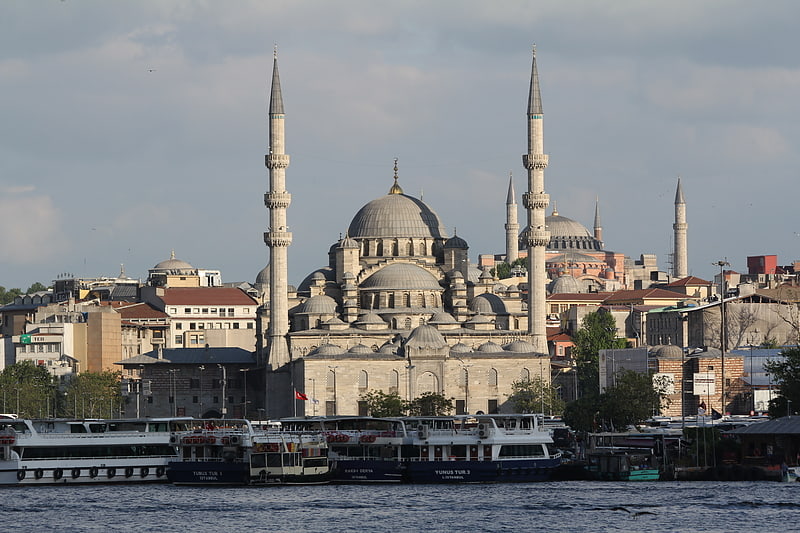
Also known as: Yeni Cami
Iconic, landmark 17th-century mosque. The New Mosque and later New Valide Sultan Mosque after its partial reconstruction and completion between 1660 and 1665, is an Ottoman imperial mosque located in the Eminönü quarter of Istanbul, Turkey. It is situated on the Golden Horn, at the southern end of the Galata Bridge. The mosque is an example of the Sultanate of Women period in Ottoman Empire.[12]
Address: Rüstem Paşa Mahallesi, Yeni Cami Cd. No:3, 34116 Fatih (Fatih)
Galata Bridge
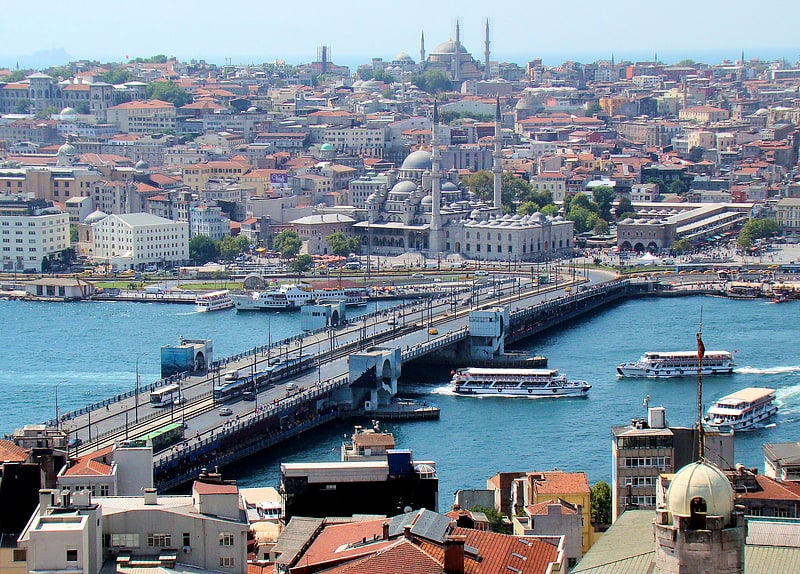
Also known as: Galata Köprüsü
Modern bridge spanning the Golden Horn. The Galata Bridge is a bridge that spans the Golden Horn in Istanbul, Turkey. From the end of the 19th century in particular, the bridge has featured in Turkish literature, theater, poetry and novels. The term "Galata Bridge" is actually a collective reference to a successive series of bridges linking Eminönü and Beyoğlu since the early 19th century. The current bridge, the fifth known by that name, was built in 1994.
It was named after Galata, the former name of the modern quarter of Karaköy in the Beyoğlu district of Istanbul, located at the northern shore of the Golden Horn.[13]
Address: Kemankeş Karamustafa Paşa Mahallesi, Galata Köprüsü, 34425 Beyoğlu
Bosphorus Bridge
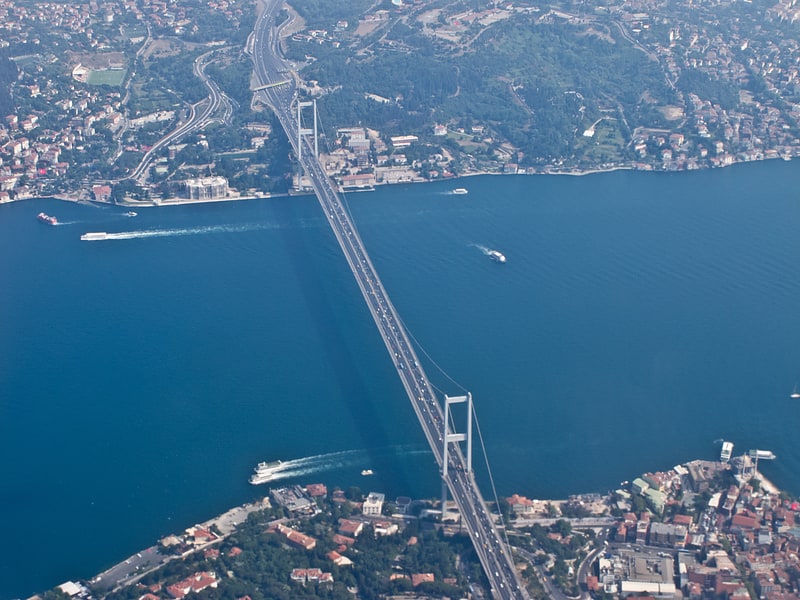
Also known as: 15 Temmuz Şehitler Köprüsü
Suspension bridge in Turkey. The Bosphorus Bridge, known officially as the 15 July Martyrs Bridge and unofficially as the First Bridge, is one of the three suspension bridges spanning the Bosphorus strait in Istanbul, Turkey, thus connecting Europe and Asia. The bridge extends between Ortaköy and Beylerbeyi.
It is a gravity-anchored suspension bridge with steel towers and inclined hangers. The aerodynamic deck hangs on steel cables. It is 1,560 m (5,118 ft) long with a deck width of 33.40 m (110 ft). The distance between the towers (main span) is 1,074 m (3,524 ft) and the total height of the towers is 165 m (541 ft). The clearance of the bridge from sea level is 64 m (210 ft).
Upon its completion in 1973, the Bosphorus Bridge had the fourth-longest suspension bridge span in the world, and the longest outside the United States (only the Verrazano-Narrows Bridge, Golden Gate Bridge and Mackinac Bridge had a longer span in 1973). The Bosphorus Bridge remained the longest suspension bridge in Europe until the completion of the Humber Bridge in 1981, and the longest suspension bridge in Asia until the completion of the Fatih Sultan Mehmet Bridge (Second Bosphorus Bridge) in 1988 (which was surpassed by the Minami Bisan-Seto Bridge in 1989). Currently, the Bosphorus Bridge has the 40th-longest suspension bridge span in the world.
After a group of soldiers took control and partially closed off the bridge during the military coup d'état attempt on 15 July 2016, Prime Minister Binali Yıldırım proclaimed on 25 July 2016 the decision of the Cabinet of Turkey that the bridge will be formally renamed as the 15 Temmuz Şehitler Köprüsü (July 15th Martyrs Bridge) in memory of those killed while resisting the attempted coup.[14]
Address: Ortaköy Mh., 34347 Beşiktaş
Beylerbeyi Palace
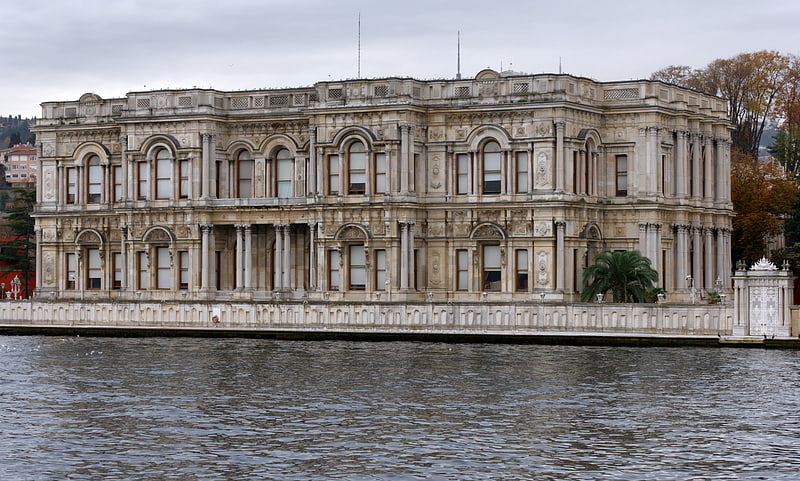
Also known as: Beylerbeyi Sarayı
Historical summer palace with gardens. The Beylerbeyi Palace, Beylerbeyi meaning "Lord of Lords", is located in the Beylerbeyi neighbourhood of Üsküdar district in Istanbul, Turkey, at the Asian side of the Bosphorus. An Imperial Ottoman summer residence built between 1861 and 1865, it is now situated immediately north of the first Bosphorus Bridge. It was the last place where Sultan Abdulhamid II was under house arrest before his death in 1918.[15]
Address: Beylerbeyi Mahallesi, Abdullahağa Cd., 34676 Üsküdar (Üsküdar)
Ortaköy Mosque
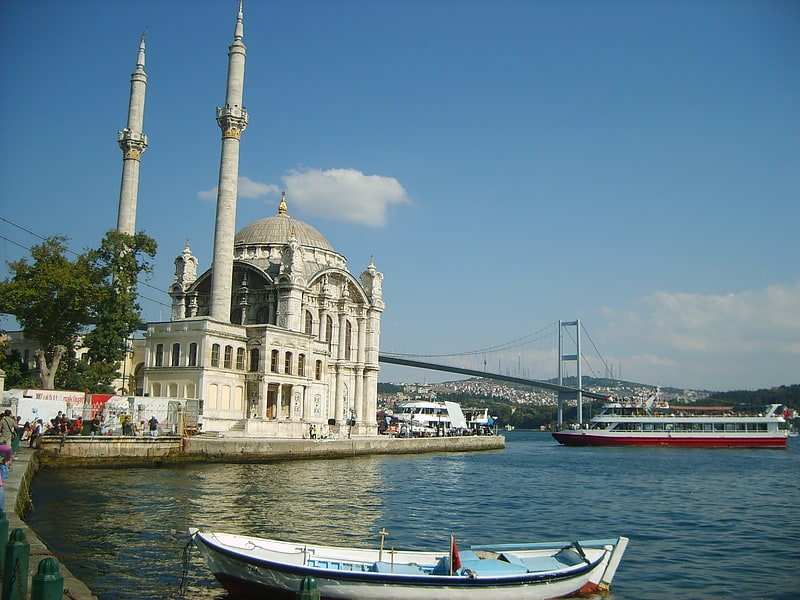
Also known as: Büyük Mecidiye Camii
Baroque mosque built to capture light. Ortaköy Mosque officially the Büyük Mecidiye Camii in Beşiktaş, Istanbul, Turkey, is situated at the waterside of the Ortaköy pier square, one of the most popular locations on the Bosphorus. This structure is symbolic of the district of Ortaköy as it has a distinctive view of the Bosphorus Strait of Istanbul and the Bosphorus Bridge. The mosque can be viewed from the Bosphorus Cruise that is popular among tourists, to go from the Asian side of Istanbul to the European side on a ferry boat.[16]
Address: Mecidiye Mahallesi, 34347 Beşiktaş (Beşiktaş)
Maiden's Tower
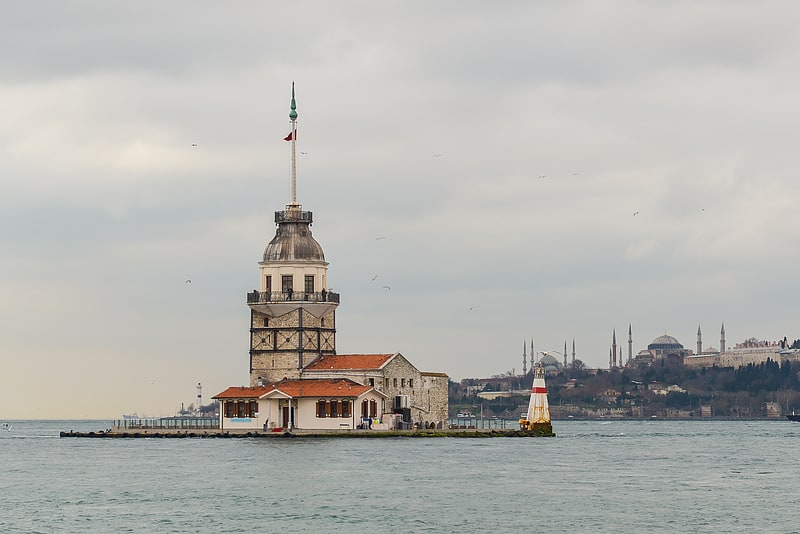
Also known as: Kız Kulesi
Iconic islet tower with boat trips. The Maiden's Tower, also known as Leander's Tower since the medieval Byzantine period, is a tower on a small islet at the southern entrance of the Bosphorus strait 200 m from the coast of Üsküdar in Istanbul, Turkey.[17]
Address: Salacak Mahallesi, Salacak Mevkii, 34668 Üsküdar
Süleymaniye Mosque
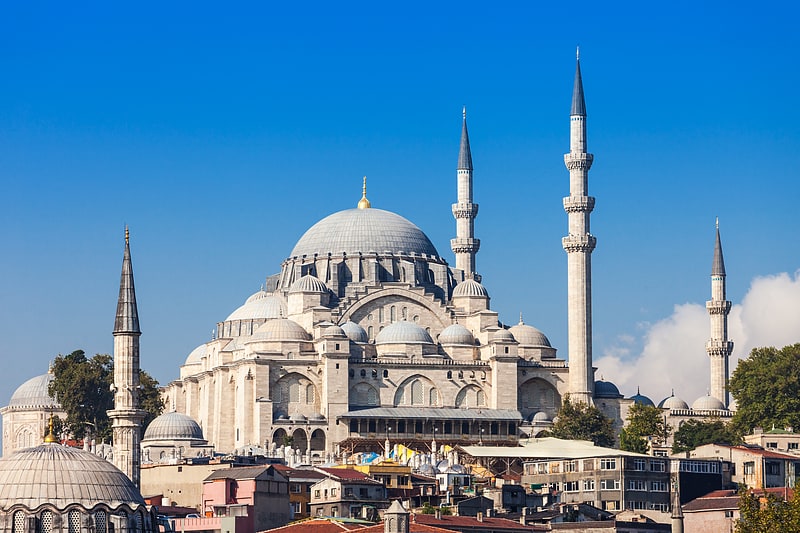
Also known as: Süleymaniye Camii
Storied 16th-century Ottoman mosque. The Süleymaniye Mosque is an Ottoman imperial mosque located on the Third Hill of Istanbul, Turkey. The mosque was commissioned by Suleiman the Magnificent and designed by the imperial architect Mimar Sinan. An inscription specifies the foundation date as 1550 and the inauguration date as 1557. Behind the qibla wall of the mosque is an enclosure containing the separate octagonal mausoleums of Suleiman the Magnificent and that of his wife Hurrem Sultan. For 462 years, the Süleymaniye Mosque was the largest mosque in the city, until it was surpassed by the Çamlıca Mosque in 2019. The Süleymaniye Mosque is one of the best-known sights of Istanbul, and from its location on the Third Hill, it commands an extensive view of the city around the Golden Horn.[18]
Address: Süleymaniye Mah, Prof. Sıddık Sami Onar Cd. No:1, 34116 Fatih (Fatih)
Obelisk of Theodosius
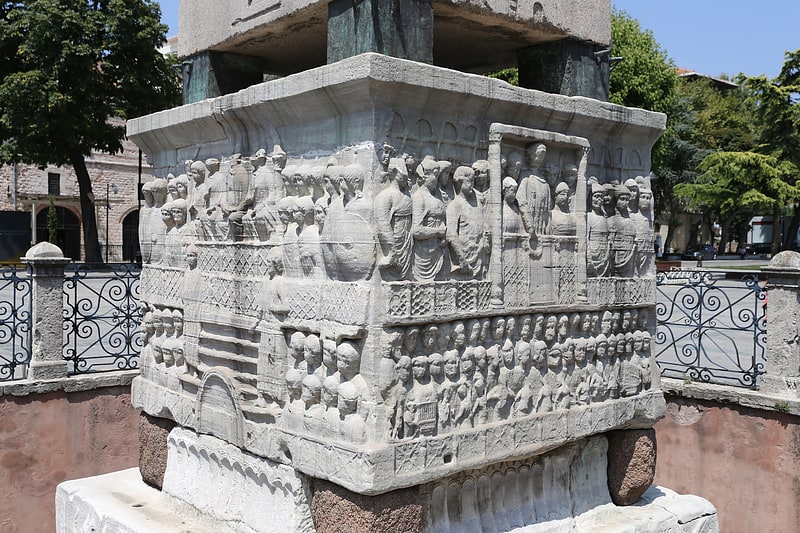
Also known as: Dikilitaş
Transplanted ancient Egyptian obelisk. The Obelisk of Theodosius is the Ancient Egyptian obelisk of Pharaoh Thutmose III re-erected in the Hippodrome of Constantinople by the Roman emperor Theodosius I in the 4th century AD.[19]
Address: Binbirdirek Mh., 34122 Fatih (Fatih)
Rüstem Pasha Mosque

Also known as: Rüstem Paşa Camii
Mosque in Istanbul, Turkey. The Rüstem Pasha Mosque is an Ottoman mosque near the Spice Bazaar located in the Hasırcılar Çarşısı in the Tahtakale neighborhood of the Fatih district, Istanbul, Turkey. Named for Rüstem Pasha, who served as Grand Vizier of the Ottoman Empire under Sultan Suleiman I, it was designed by the Ottoman imperial architect Mimar Sinan and completed in around 1563.[20]
Address: Rüstem Paşa Mahallesi, Hasırcılar Cd. No:62, 34116 Fatih (Fatih)
Borusan Contemporary

Perili Köşk is a historical monument at the Rumelihisarı neighbourhood of the Sarıyer district in Istanbul, Turkey.
Built in 1911, the castle-like red brick mansion with stained glass windows is located close to the Fatih Sultan Mehmet Bridge, on the European shore of the Bosphorus strait. The building has 9 floors above ground level and has a gross floor area of around 5,000 m2 (54,000 sq ft).
The popular nickname of the mansion, Perili Köşk (meaning the "Haunted Mansion" in Turkish) refers to its construction remaining partially unfinished for a long period (its second and third floors remained empty for decades.) The building's exterior appearance was carefully restored and completed in line with the original design between 1995 and 2000 by architect Hakan Kıran, who also renovated its interior.
Perili Köşk is also the title of a story by the Turkish author Ömer Seyfettin.[21]
Address: Rumeli Hisarı, 34470 Rumeli Hisarı - Sarıyer/Sarıyer (Sarıyer)
Rumelihisarı

Also known as: Rumeli Hisarı
Ancient fortress with panoramic views. Rumelihisarı or Boğazkesen Castle is a medieval fortress located in Istanbul, Turkey, on a series of hills on the European banks of the Bosphorus. The fortress also lends its name to the immediate neighborhood around it in the city's Sarıyer district.
Conceived and built between 1451 and 1452 on the orders of Ottoman Sultan Mehmed II, the complex was commissioned in preparation for a planned Ottoman siege on the then-Byzantine city of Constantinople, with the goal of cutting off maritime military and logistical relief that could potentially come to the Byzantines' aid by way of the Bosphorus Strait, hence the fortress's alternative name, "Boğazkesen", i.e. "Strait-cutter" Castle. Its older sister structure, Anadoluhisari ("Anatolian Fortress"), sits on the opposite banks of the Bosporus, and the two fortresses worked in tandem during the final siege to throttle all naval traffic along the Bosphorus, thus helping the Ottomans achieve their goal of making the city of Constantinople (later renamed Istanbul) their new imperial capital in 1453.
After the Ottoman conquest of the city, Rumelihisarı served as a customs checkpoint and occasional prison, notably for the embassies of states that were at war with the Empire. After suffering extensive damage in the Great Earthquake of 1509, the structure was repaired, and was used continuously until the late 19th century.
Today, the fortress is a popular museum open to the public, and further acts as an open-air venue for seasonal concerts, art festivals, and special events.[22]
Address: Tarabya Yenikoy Cad., Istanbul (Sarıyer)
Beyoğlu
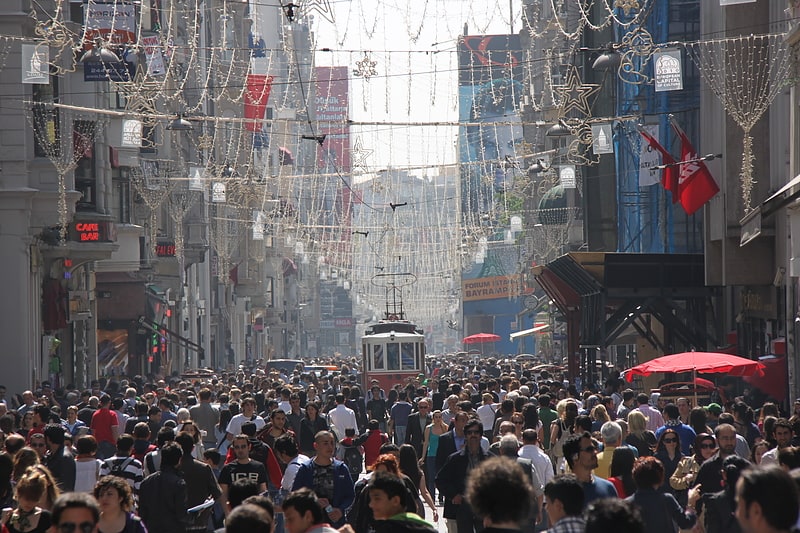
Beyoğlu is a district on the European side of İstanbul, Turkey, separated from the old city by the Golden Horn. It was known as the region of Pera surrounding the ancient coastal town Galata which faced Constantinople across the Horn. Beyoğlu continued to be named Pera during the Middle Ages and, in western languages, into the early 20th century.
According to the prevailing theory, the Turkish name of Pera, Beyoğlu, is a modification by folk etymology of the Venetian ambassadorial title of Bailo, whose palazzo was the most grandiose structure in this quarter. The informal Turkish-language title Bey Oğlu (literally Son of a Bey) was originally used by the Ottoman Turks to describe Lodovico Gritti, Istanbul-born son of Andrea Gritti, who was the Venetian Bailo in Istanbul during the reign of Sultan Bayezid II (r. 1481–1512) and was later elected Doge of Venice in 1523. Bey Oğlu thus referred to Lodovico Gritti, who established close relations with the Sublime Porte, and whose mansion was near the present-day Taksim Square. Located further south in Beyoğlu and originally built in the early 16th century, the "Venetian Palace" was the seat of the Bailo. The original palace building was replaced by the existing one in 1781, which later became the Italian Embassy following Italy's unification in 1861, and the Italian Consulate in 1923, when Ankara became the capital of the Republic of Turkey.
The district encompasses other neighborhoods located north of the Golden Horn, including Galata (the medieval Genoese citadel from which Beyoğlu itself originated, which is today known as Karaköy), Tophane, Cihangir, Şişhane, Tepebaşı, Tarlabaşı, Dolapdere and Kasımpaşa, and is connected to the old city center across the Golden Horn through the Galata Bridge, Atatürk Bridge and Golden Horn Metro Bridge. Beyoğlu is the most active art, entertainment and nightlife centre of Istanbul.[23]
Esma Sultan Mansion
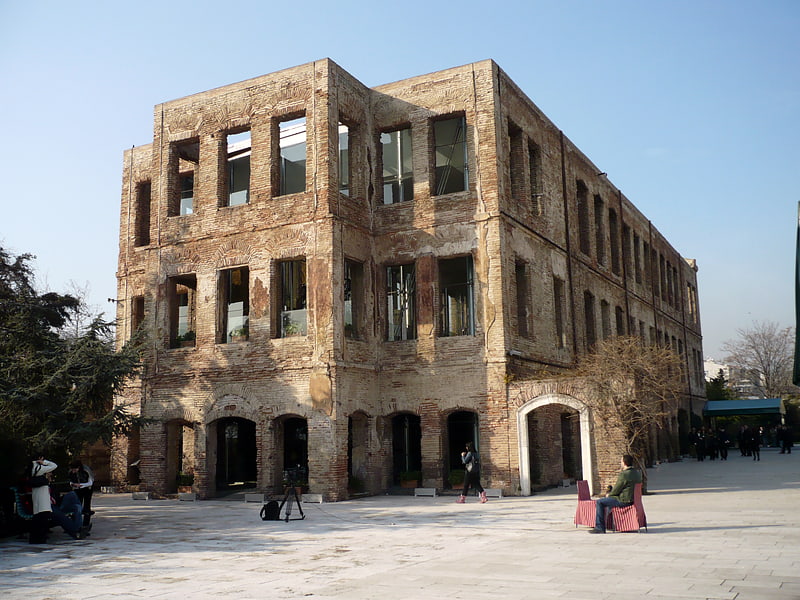
The Esma Sultan Mansion, a historical yalı located on the Bosphorus in the Ortaköy neighborhood of Istanbul, Turkey and named after its original owner Princess Esma Sultan, is used today as a cultural center after being redeveloped.[24]
Address: Yalı Çıkmazı, Istanbul (Beşiktaş)
Galatasaray Museum
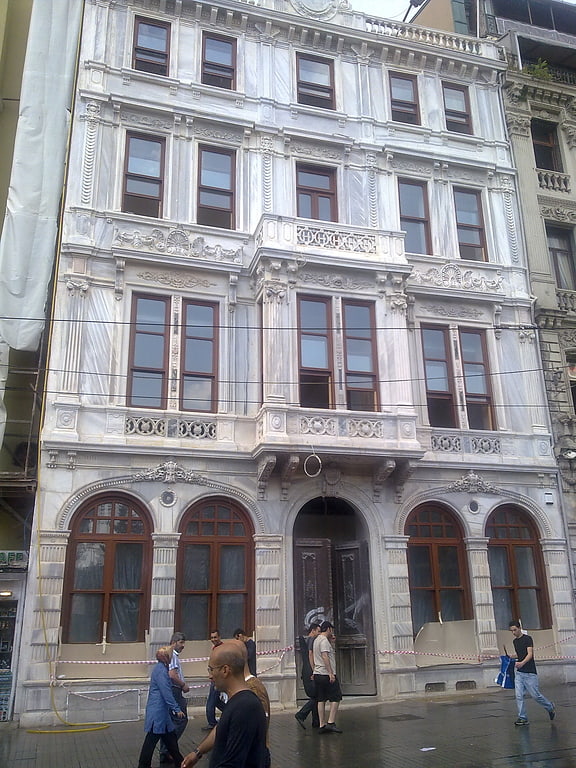
Also known as: Galatasaray Müzesi
Cultural center in Turkey. Galatasaray Museum is a cultural center in Istanbul, Turkey, founded in 1868 to inform the society of the traditions and history of Galatasaray. The museum is open to the public every day except Mondays.[25]
Address: Galatasaray Meydanı, 34400 Beyoğlu (Beyoğlu)
Yıldız Palace
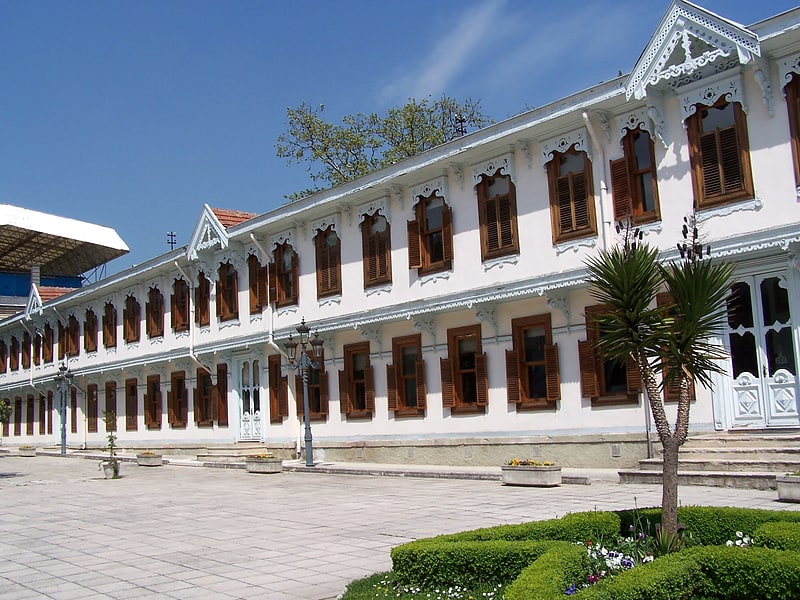
Also known as: Yıldız Sarayı
Museum in palace complex from the 1880s. Yıldız Palace is a vast complex of former imperial Ottoman pavilions and villas in Istanbul, Turkey, built in the 19th and early 20th centuries. It was used as a residence by the Sultan and his court in the late 19th century.[26]
Address: Yıldız Mh., Yıldız Cd. No:62, 34349 Beşiktaş (Beşiktaş)
Hagia Irene
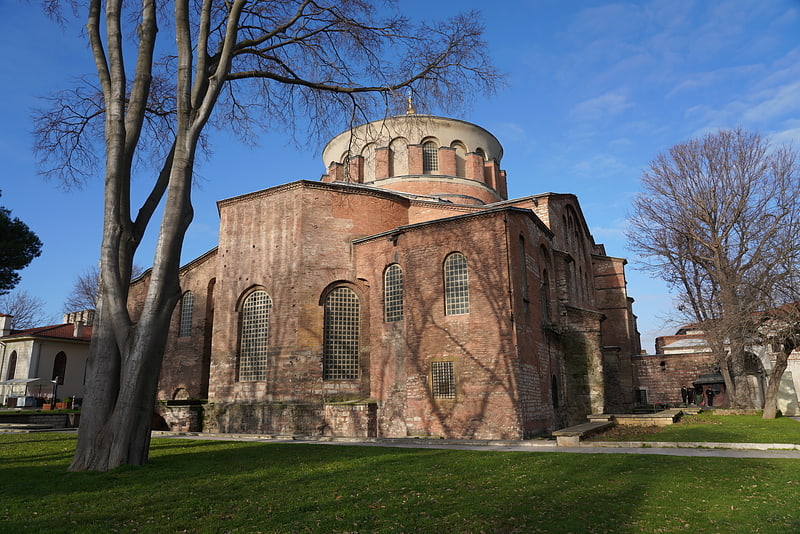
Also known as: Aya İrini
4th-century Byzantine church museum. Hagia Irene or Hagia Eirene, sometimes known also as Saint Irene, is an Eastern Orthodox church located in the outer courtyard of Topkapı Palace in Istanbul. It is one of the few churches in Istanbul that has not been converted into a mosque, as it was used as an arsenal for storing weapons until the 19th century. The Hagia Irene today operates as a museum and concert hall.[27]
Address: Sultanahmet Meydani Topkapi Sarayi 1. Avlusu, 34122 Istanbul (Fatih)
Dolmabahçe Mosque
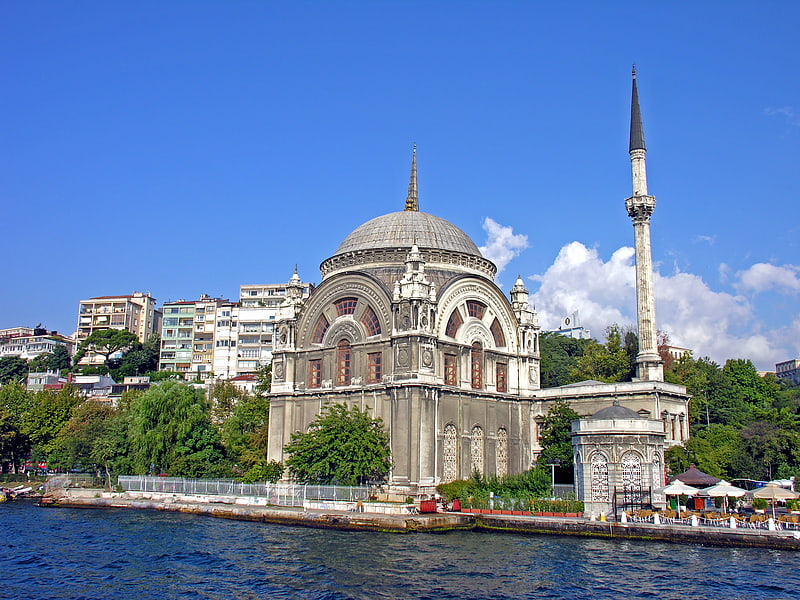
Also known as: Dolmabahçe Camii
Ottoman-style mosque completed in 1853. The Dolmabahçe Mosque is a mosque in Istanbul, Turkey. It was commissioned by queen mother Bezmi Alem Valide Sultan.[28]
Address: Ömer Avni Mh., 34427 Beyoğlu (Beyoğlu)
Adile Sultan Sarayı
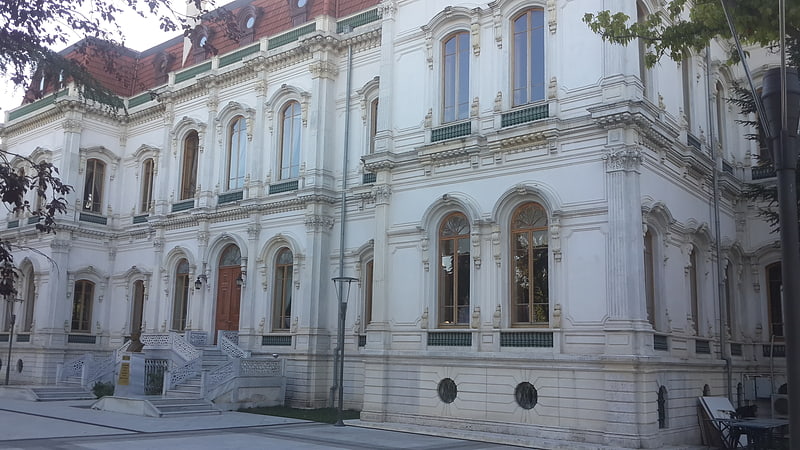
Royal residence. Adile Sultan Palace is the former royal residence of Ottoman princess Adile Sultan. It was donated to the state by Adile Sultan to be used as a school building for the Kandilli Anatolian High School for Girls and is today a cultural center. It is located in the Kandilli neighbourhood of Istanbul, Turkey.[29]
Address: Kandilli mah. Kandilli Cad. Liseli sok. Kandilli / Üsküdar, Istanbul (Üsküdar)
Küçüksu Pavilion
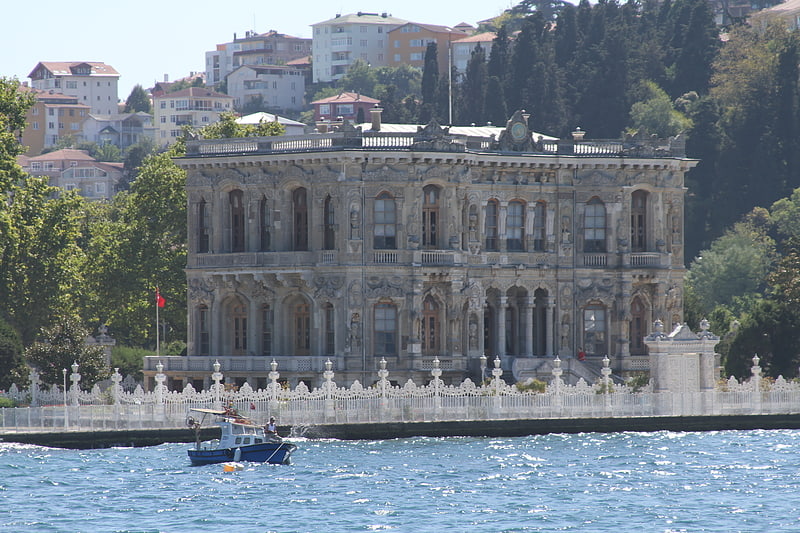
Also known as: Küçüksu Kasrı
Historic sultan's palace . Küçüksu Pavilion, Littlewater Pavilion a.k.a. Göksu Pavilion, is a summer pavilion in Istanbul, Turkey, situated in the Küçüksu neighborhood of Beykoz district on the Asian shore of the Bosphorus between Anadoluhisarı and the Fatih Sultan Mehmet Bridge. The pavilion was used by Ottoman sultans for short stays during country excursions and hunting.[30]
Address: Göksu Mahallesi, Küçüksu Cd., 34815 Beykoz (Beykoz)
Yıldız Parkı
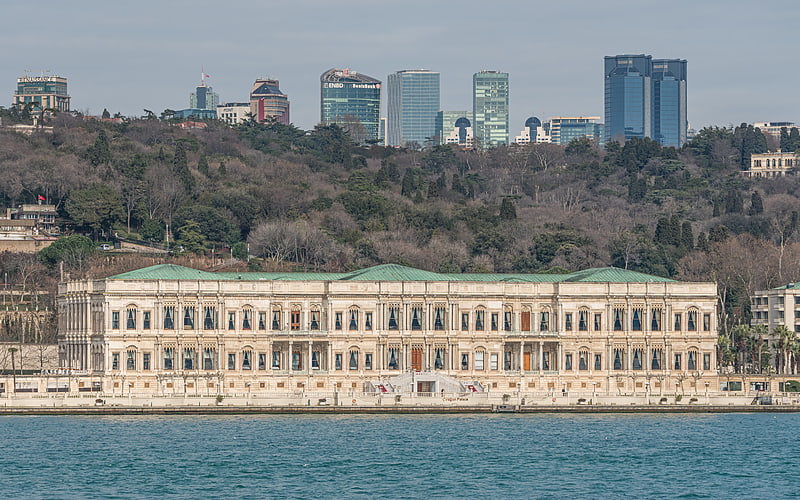
City park with an Ottoman palace museum. Yıldız Park is a historical, urban park in Beşiktaş district of Istanbul, Turkey. It is one of the largest public parks in Istanbul. The park is located in Yıldız quarter between the palaces of Yıldız and Çırağan.[31]
Address: Yıldız Korusu, Istanbul (Beşiktaş)
Naval Museum
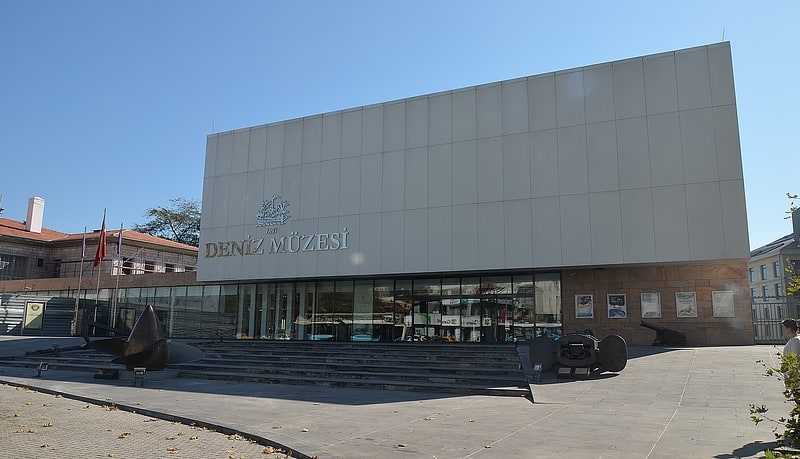
Also known as: İstanbul Deniz Müzesi
Museum in Istanbul, Turkey. The Istanbul Naval Museum is a national naval museum, located at Beşiktaş district of Istanbul in Turkey. It was established in 1897 by the Ottoman Minister of Navy Bozcaadalı Hasan Hüsnü Pasha.
The museum contains an important collection of military artifacts pertaining to the Ottoman Navy. In the field of maritime, it is Turkey's largest museum, with a great variety of collections. Around 20,000 pieces are present in its collection, including the galley Tarihi Kadırga, used during the reign of sultan Mehmet IV.
Being connected to the Turkish Navy-Command in Turkey, it is also the country's first military museum.
A new exhibition building was constructed. The construction lasted five years, and the building was reopened on October 4, 2013. It has two storeys in addition a basement, all covering 20,000 m2 (220,000 sq ft).
The basement consists of diverse items like figureheads, ornaments of naval ships, ship models and pieces of the Byzantine chain used to block entrance of enemy ships into the Golden Horn. In the first and second floors, a great number of imperial and other caïques are exhibited.
Many exhibition items underwent special restoration and conservation works due to deformation of the raw materials caused by heat, light, humidity, atmospheric conditions, vandalism and other factors.[32]
Address: Yıldız Mh., Kilimci Sokak No:6, 34349 Beşiktaş (Beşiktaş)
Emirgan Park
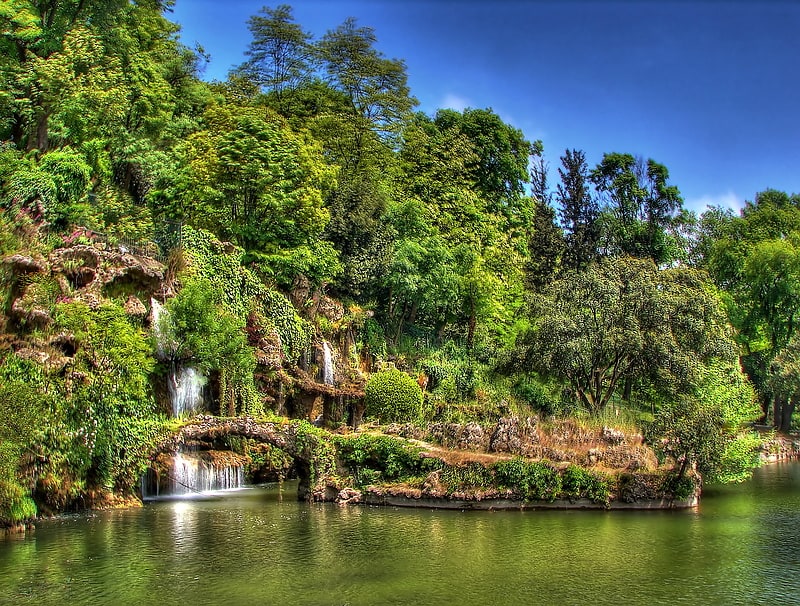
Also known as: Emirgân Korusu
Picturesque park with play areas and paths. The Emirgan Park is a historical urban park located at the Emirgan neighbourhood in the Sarıyer district of Istanbul, Turkey, on the European coast of the Bosphorus. It is one of the largest public parks in Istanbul.[33]
Address: Emirgan Mahallesi, Emirgan Sk., 34467 Sarıyer (Sarıyer)
Tiled Kiosk

Also known as: Çinili Köşk
Museum in Istanbul, Turkey. The Tiled Kiosk is a pavilion set within the outer walls of Topkapı Palace and dates from 1472 as shown on the tile inscript above the main entrance. It was built by the Ottoman sultan Mehmed II as a pleasure palace or kiosk. It is located in the most outer parts of the palace, next to Gülhane Park. It was also called Glazed Kiosk.
It was used as the Imperial Museum (Ottoman Turkish: Müze-i Hümayun, Turkish: İmparatorluk Müzesi) between 1875 and 1891. In 1953, it was opened to the public as a museum of Turkish and Islamic art, and was later incorporated into the Istanbul Archaeology Museums, housing the Museum of Islamic Art. The pavilion contains many examples of İznik tiles and Seljuk pottery.[34]
Address: İstanbul Arkeoloji Müzeleri, 34122 Fatih (Fatih)
Eyüp Sultan Mosque
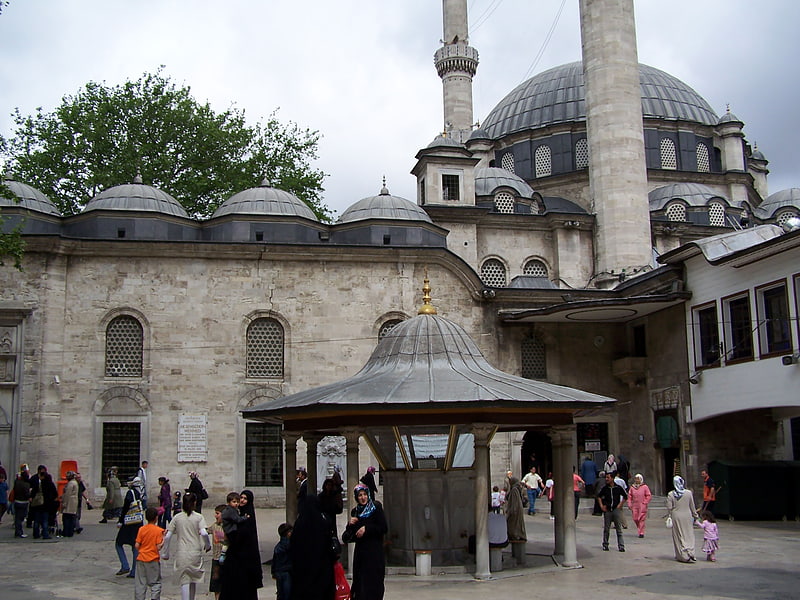
Also known as: Eyüp Sultan Camii
Historic mosque with a mausoleum. The Eyüp Sultan Mosque is a mosque situated in the Eyüp district of Istanbul, outside the city walls near the Golden Horn. The present building dates from the beginning of the 19th century. The mosque complex includes a mausoleum marking the spot where Abu Ayyub al-Ansari, the standard-bearer and friend of the Islamic prophet Muhammad, is said to have been buried.[35]
Address: Merkez Mh, Cami Kebir Sk. No:1, 34050 Eyüp (Eyüp)